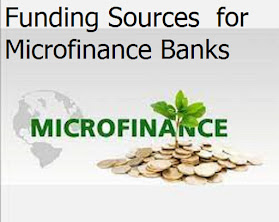Funding Sources for Microfinance Banks
Funding Sources for Microfinance Banks
Funding sources for microfinance banks are regulated and the need to adhere to regulatory provisions cannot be over emphasized.
WHAT IS MICROFINANCE
Most microfinance institutions focus on offering credit in the form of small working capital loans, sometimes called microloans or microcredit.
Sources from funding sources for ease of understanding.
#A Shareholders’ funds (Paid-up share capital and reserves): This is the owners’ equity. The funds put together by the owners verified and approved by CENTRAL BANKS. It usually comes at no cost to the business.
#B Deposits/Savings of customers: As operation progresses, the business is expected to generate cashflow through the sale of products and services designed for customers. Here, products can be designed to attract savings, deposit with fixed term and interest, with a view to creating liquidity for the business.
#C Debenture/Qualifying medium to long term loans: Where the #MICROFINANCE is unable to mobilize sufficient deposit to fund the business, it can resort to long-term borrowings at a fixed cost and tenor. Such funding can take the shape of overdraft to cover short term gaps, medium term loans from other financial institutions or long term funds that can be categorized as secondary capital of the MICROFINANCE. Where applicable, these borrowings may require security in the form of debenture.
#D Grants/Donations from individuals, organizations, national government, and international sources: Since MICROFINANCE are closer to the grassroots, individuals and organizations whether for profit or not for profit usually would like to leverage on the coverage and proximity to express their philanthropic tendencies and corporate social responsibility. Some are target specific such as technology, food security, poverty alleviation, women empowerment, financial inclusion, agriculture, etc. Most Microfinance Banks are funded by the government and politicians have also funded the use of MICROFINANCE platform as a veritable tool to reach out to their targeted audience.
Havelet Finance Limited have a recorded numbers of Microfinance banks in Africa, Asia especially in South Korea who’s funding sources is from our company. What they do is to receive funding from Havelet Finance Limited at a rate of 2% annually and give out to a local group with small business at 15% interest rate monthly.
If you are a retired banker or an experienced personnel is have a fund management capability with a good experience that need to maximize this funding opportunity to expedite registered Microfinance bank project in his locality kindly contact us we will assist you.
Revenue Sources
These are the various sources through which financial value is added when your #cashflow is put into use through the sale of Microfinance product and services.
#I). Fees and Commissions: These are the rewards MICROFINANCE BANKS receive on rendering specific services. Management, processing, commitment, transfer fees are familiar to customers when loans are disbursed to them or when they request for local transfer services.
#ii). Interest income: This is the reward the MICROFINANCE receives when loans are granted to customers. It usually constitutes over 70% of the total MICROFINANCE revenue.
Havelet Finance Limited is available for all loans. Contact us below;

Comments
Post a Comment